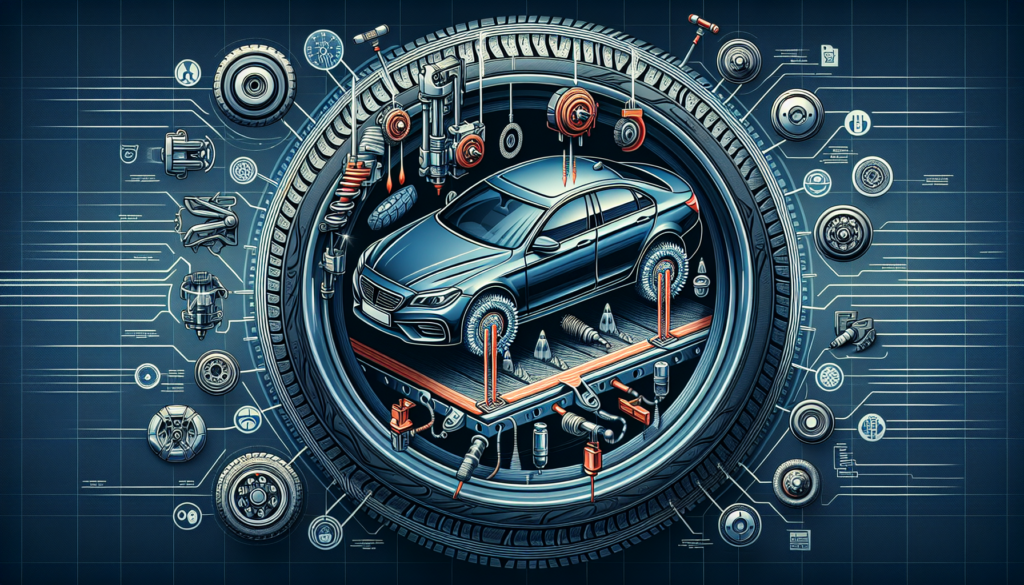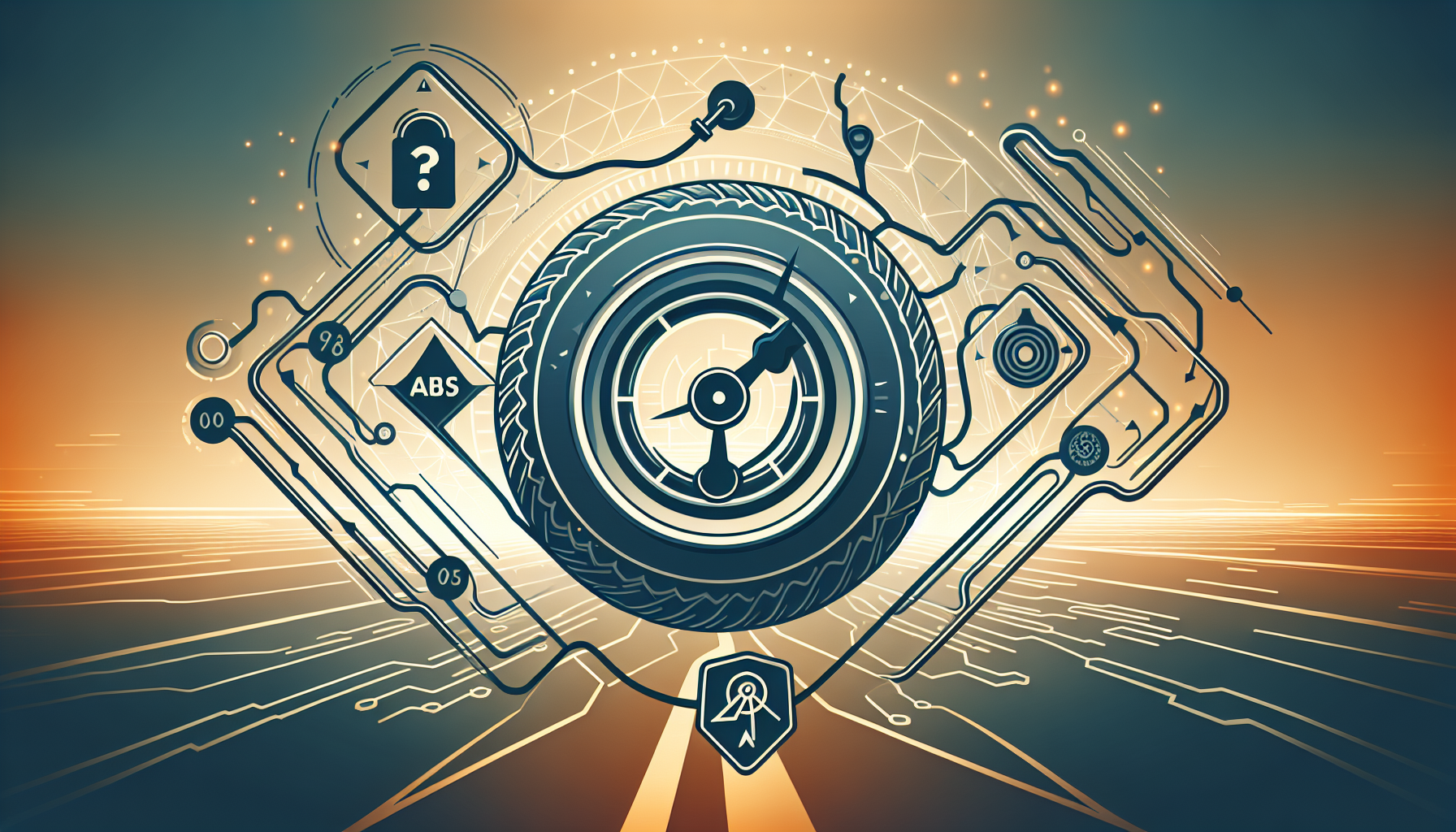Did you know that something as simple as tire pressure can impact the performance of your car’s ABS and traction control systems? It may sound surprising, but the pressure level of your tires can play a significant role in how well these safety features work. In this article, we will explore the connection between tire pressure and ABS/traction control performance, and discuss why it is crucial to maintain the correct tire pressure for optimal safety on the road. So, let’s dive right in and discover how tire pressure can impact your car’s handling and braking abilities!

Overview of ABS and Traction Control Systems
Explanation of ABS
ABS, or Anti-lock Braking System, is a safety feature in vehicles that prevents the wheels from locking up during braking. It utilizes sensors to monitor the rotational speed of each wheel. If the system detects that a wheel is about to lock up, it automatically modulates the brake pressure to that particular wheel. This allows the driver to maintain steering control and prevents skidding, which can be extremely dangerous in emergency braking situations.
Explanation of Traction Control
Traction Control is another safety feature designed to prevent the wheels from spinning excessively during acceleration. It uses the same wheel speed sensors as ABS to detect if one or more wheels are spinning faster than the others. When this occurs, the system engages and reduces engine power or applies the brakes to regain traction. Traction Control is particularly helpful in slippery or low-traction conditions, such as driving on wet or icy roads.
Importance of ABS and Traction Control in Vehicles
Both ABS and Traction Control are crucial safety features that significantly enhance the stability and control of a vehicle. They help to prevent accidents and improve overall handling performance. By ensuring that the wheels maintain contact with the road surface, these systems allow the driver to maintain control, especially in challenging driving conditions. ABS and Traction Control work hand in hand to provide a safer driving experience and reduce the risk of accidents caused by skidding, sliding, or loss of traction.
Understanding Tire Pressure
Definition of Tire Pressure
Tire pressure refers to the amount of air inside a tire, measured in pounds per square inch (PSI). It is a critical factor in maintaining optimal tire performance and vehicle safety. The recommended tire pressure can usually be found in the vehicle owner’s manual or on a sticker located on the driver’s side door jamb. It is important to note that the recommended tire pressure may vary depending on the vehicle’s make and model and the type of tires being used.
Effects of Low Tire Pressure
When tire pressure is too low, it can have several negative effects on both the vehicle’s performance and safety. Firstly, low tire pressure reduces the contact area between the tire and the road surface. This results in decreased traction and increased braking distances. Additionally, low tire pressure can cause the tire to flex excessively, leading to increased heat generation and potential tire failure. It can also result in uneven tire wear, reduced fuel efficiency, and compromised handling and stability.
Effects of High Tire Pressure
Similarly, high tire pressure can also have adverse effects on the vehicle’s performance and safety. With excessive air pressure, the tire becomes overinflated and the contact area with the road diminishes. This reduces traction and can lead to decreased control and longer braking distances. Moreover, high tire pressure causes the center of the tire tread to wear out faster, resulting in uneven tire wear. It can also lead to a rougher ride quality and increased vulnerability to tire damage, particularly on bumpy or uneven roads.
Relationship between Tire Pressure and ABS Performance
Effect of Low Tire Pressure on ABS
Low tire pressure can negatively impact the performance of ABS. When the tires are underinflated, the contact area with the road decreases, causing a reduction in traction. This reduced traction can interfere with the ABS system’s ability to accurately sense and modulate brake pressure. As a result, the ABS may not be able to prevent wheel lock-up effectively, compromising the braking performance and stability of the vehicle.
Effect of High Tire Pressure on ABS
On the other hand, high tire pressure can also have a detrimental effect on ABS performance. Overinflated tires have a reduced contact area, leading to decreased traction. In this scenario, the ABS system may falsely detect a wheel lock-up and unnecessarily activate, resulting in premature braking intervention and reduced braking efficiency. The excessive stiffness of overinflated tires can also lead to a harsher ride, making it more challenging for the ABS system to maintain control when braking.
Relationship between Tire Pressure and Traction Control Performance
Effect of Low Tire Pressure on Traction Control
Low tire pressure has a direct impact on the performance of the traction control system. When the tires are underinflated, the reduced contact area with the road surface decreases traction. This decreases the system’s effectiveness in preventing wheel spin and regaining traction. The traction control system may struggle to modify engine power or apply the brakes to the spinning wheel correctly, leading to compromised acceleration and reduced stability.
Effect of High Tire Pressure on Traction Control
Similarly, high tire pressure can also affect the performance of traction control. Overinflated tires have diminished traction due to a reduced contact area. This makes it more challenging for the traction control system to regulate power delivery and braking when wheel spin occurs. The system may not be able to effectively reduce engine power or apply the brakes to the spinning wheel, resulting in prolonged wheel spin and compromised traction control performance.

Factors Influencing ABS and Traction Control Performance
Tire Grip and Contact Patch
The grip and size of the contact patch, which is the area where the tire contacts the road surface, play a crucial role in the performance of ABS and traction control. Proper tire pressure ensures an optimal contact patch size, maximizing traction and allowing these systems to function effectively. When tire pressure is too low or too high, the contact patch is compromised, reducing traction and hindering the ability of ABS and traction control systems to maintain control and stability.
Response Time of ABS and Traction Control Systems
The speed at which ABS and traction control systems can detect and respond to changes in wheel speed is vital to their performance. When tire pressure is at the recommended level, the response time of these systems is optimized, allowing them to engage quickly and prevent wheel lock-up or excessive wheel spin. However, if tire pressure is too low or too high, it can impact the accuracy and effectiveness of these systems, leading to slower response times and compromised safety.
Vehicle Stability and Handling
The stability and handling of a vehicle are influenced by tire pressure. When tire pressure is within the recommended range, the vehicle maintains proper stability and handling characteristics. This is crucial for the effective operation of ABS and traction control systems. However, when tire pressure deviates from the optimal range, it can negatively affect the vehicle’s stability and handling, reducing the ability of ABS and traction control to maintain control of the vehicle in emergency situations.
Optimum Tire Pressure for ABS and Traction Control Performance
Recommended Tire Pressure Range
To ensure optimal ABS and traction control performance, it is essential to maintain tire pressure within the recommended range specified by the vehicle manufacturer. This information can typically be found in the vehicle owner’s manual or on a sticker located on the driver’s side door jamb. Adhering to the recommended tire pressure range will ensure an adequate contact patch size, maximum traction, and enable ABS and traction control systems to function optimally.
How to Check and Maintain Proper Tire Pressure
Regularly checking and maintaining proper tire pressure is vital for the safety and performance of ABS and traction control systems. To check tire pressure, you can use a tire pressure gauge, readily available at most automotive stores. Simply remove the valve cap from the tire, firmly press the gauge onto the valve stem, and note the reading. If the pressure is too low, add air until it reaches the recommended level. If the pressure is too high, release air until it reaches the appropriate range. It is recommended to check tire pressure at least once a month and before embarking on long trips.
Ensuring Optimal Performance of ABS and Traction Control
To ensure optimal ABS and traction control performance, it is also essential to regularly inspect tires for any signs of damage or wear and replace them when necessary. Maintaining a consistent service schedule, including regular rotation, alignment, and balancing of tires, is also crucial. These maintenance practices help to optimize tire performance, maintain proper traction, and ensure the overall effectiveness of ABS and traction control systems.

Impact of Tire Pressure on Braking Distance
Relation between Tire Pressure and Braking Distance
Tire pressure plays a significant role in determining the braking distance of a vehicle. When tire pressure is at the recommended level, the tire maintains ideal contact with the road surface, maximizing traction and improving braking efficiency. This results in shorter braking distances, allowing the vehicle to come to a stop more quickly. However, if tire pressure is too low or too high, the reduced contact area or decreased traction can lead to longer braking distances, compromising safety and increasing the risk of accidents.
Braking Performance with Low Tire Pressure
Low tire pressure negatively affects braking performance. When the tires are underinflated, the contact area decreases, reducing traction and compromising the effectiveness of the ABS system. This can lead to longer braking distances, as the wheels are more prone to lock-up or skid. Additionally, low tire pressure can cause the tires to overheat, further diminishing their ability to provide optimal grip during braking, resulting in a longer stopping distance.
Braking Performance with High Tire Pressure
Similarly, high tire pressure can also impact braking performance. Overinflated tires have a reduced contact area, diminishing traction and increasing the risk of wheel lock-up. In such cases, the ABS system may constantly activate, causing premature braking intervention and potentially extending the braking distance. The lack of proper grip due to overinflated tires can also result in decreased braking efficiency and increased stopping distances.
Tire Pressure Monitoring Systems (TPMS)
Introduction to TPMS
Tire Pressure Monitoring Systems (TPMS) are electronic systems designed to monitor the air pressure of tires in real-time. TPMS typically employs sensors located in each tire to continuously transmit pressure data to a control module. This information is then displayed to the driver, alerting them if any tire’s pressure drops below or exceeds the recommended range. TPMS ensures that drivers can easily and quickly identify any tire pressure issues, allowing for prompt corrective action.
Benefits of TPMS
TPMS offers several benefits in terms of safety, performance, and convenience. Firstly, it enhances driver safety by providing real-time monitoring and alerts for abnormal tire pressure conditions, minimizing the risk of tire-related accidents. Furthermore, TPMS helps to optimize fuel efficiency by ensuring that tire pressures are within the appropriate range, reducing rolling resistance. Additionally, by monitoring tire pressure, TPMS helps to extend tire life, enhance overall handling performance, and minimize the risk of tire failure or blowouts.
Role of TPMS in Maintaining Optimal Performance of ABS and Traction Control
TPMS plays a vital role in maintaining the optimal performance of ABS and traction control systems. By continuously monitoring tire pressure, TPMS ensures that the tires are inflated within the recommended range, facilitating the maximum contact patch size and maintaining optimal traction. This allows ABS and traction control to function effectively, enhance vehicle stability and control, and reduce the risk of accidents caused by wheel lock-up or excessive wheel spin.

Safety Considerations
Importance of Regular Tire Pressure Checks
Regular tire pressure checks are of utmost importance for vehicle safety. As tire pressure directly affects the performance of ABS and traction control systems, maintaining optimal tire pressure ensures that these safety features can function efficiently. Regular checks not only help to maintain proper traction and braking performance but also allow for the early detection of any tire-related issues, such as leaks or punctures. By promptly addressing these issues, accidents caused by tire failures can be prevented.
Signs of Improper Tire Pressure
In addition to regular tire pressure checks, drivers should also be vigilant for signs of improper tire pressure. These signs may include uneven tread wear, decreased fuel efficiency, decreased handling or stability, increased braking distances, vibration or shaking while driving, and frequent tire pressure warning alerts from the TPMS. If any of these signs are observed, it is crucial to check the tire pressure promptly and make any necessary adjustments or repairs.
Consequences of Neglecting Tire Pressure
Neglecting proper tire pressure maintenance can have severe consequences. Inadequate tire pressure compromises the performance and effectiveness of ABS and traction control systems, increasing the risk of accidents and loss of vehicle control. Additionally, incorrect tire pressure can lead to decreased fuel efficiency, premature tire wear, and diminished overall handling and stability. Negligence in maintaining proper tire pressure can also result in tire blowouts or failures, which can lead to hazardous situations on the road.
Conclusion
Summary of the Impact of Tire Pressure on ABS and Traction Control
In conclusion, tire pressure plays a crucial role in the performance of ABS and traction control systems. Maintaining the recommended tire pressure allows these safety features to function optimally, enhancing vehicle stability, control, and safety. Low tire pressure reduces traction, compromises braking performance, and hinders the operation of ABS and traction control systems. Conversely, high tire pressure also impairs traction, leading to compromised braking and traction control performance.
Importance of Tire Pressure Maintenance for Vehicle Safety
To ensure the safe operation of a vehicle, it is vital to frequently check and maintain the proper tire pressure within the recommended range. Regular tire pressure checks, along with proper tire maintenance practices, such as rotation, alignment, and balancing, are necessary to maximize tire performance, enhance ABS and traction control systems, and minimize the risk of accidents caused by wheel lock-up, excessive wheel spin, or loss of traction. By prioritizing tire pressure maintenance, drivers can significantly improve the safety, performance, and longevity of their vehicles.


